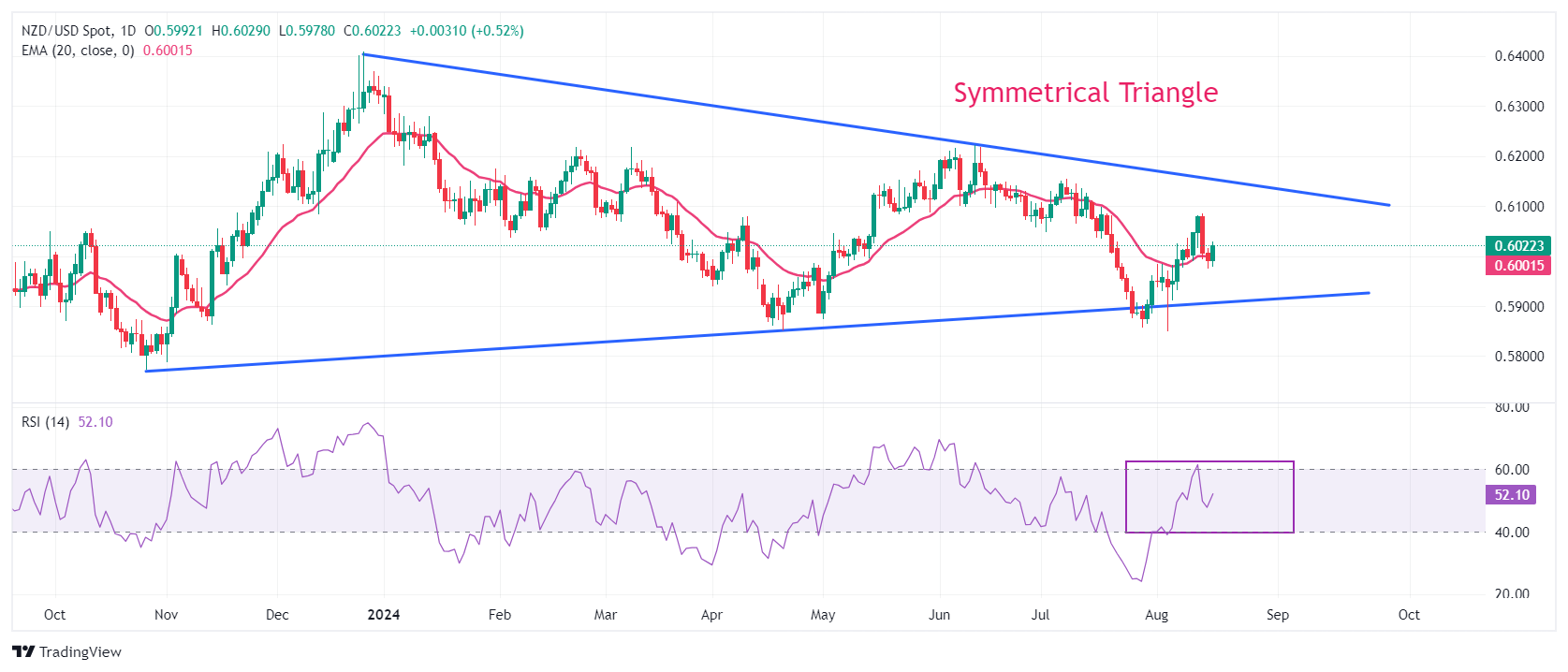NZD/USD Price Forecast: Rallies to near 0.6030 on upbeat market sentiment


- NZD/USD soars to near 0.6030 as market sentiment favors risky assets.
- The RBNZ surprisingly announced an interest rate cut by 25 bps on Wednesday.
- Firm Fed rate-cut prospects keep the US Dollar’s upside limited.
The NZD/USD pair surges to near 0.6030 in Friday’s European session. The Kiwi asset strengthens as appeal for risky assets has improved. Market sentiment improves significantly as fears of the United States (US) entering a recession have ebbed on upbeat Retail Sales for July and lower weekly Jobless Claims in the week ending August 9.
S&P 500 futures have posted decent gains in European trading hours, demonstrating an improvement in investors’ risk-appetite. The US Dollar Index (DXY), which tracks the Greenback’s value against six major currencies, falls to near 102.80.
However, the near-term appeal of the New Zealand Dollar (NZD) remains uncertain as the Reserve Bank of New Zealand (RBNZ) unexpectedly reduced its Official Cash Rate (OCR) by 25 basis points (bps) to 5.25% on Wednesday.
Meanwhile, the next move in the US Dollar will be guided by the market speculation for the Federal Reserve (Fed) interest rate cut path for the entire year. For that, investors await Fed Chair Jerome Powell’s speech at the upcoming Jackson Hole (JH) symposium, which will be held from August 22-24.
NZD/USD trades in a Symmetrical Triangle chart pattern on a daily timeframe, which exhibits a sharp volatility contraction. The Kiwi asset rises above the 20-day Exponential Moving Average (EMA) near 0.6000, suggesting that the near-term trend is bullish.
The 14-day Relative Strength Index (RSI) oscillates in the 40.00-60.00 range, indicating indecisiveness among market participants.
More upside would appear if the asset decisively breaks May 3 high at 0.6046. This would push the asset higher to July 17 high near 0.6100 and July 12 high of 0.6127.
In an alternate scenario, a downside move below April 19 low around 0.5850 would drag the asset towards the round-level support of 0.5800, followed by 26 October 2023 low at 0.5770.

NZD/USD daily chart
New Zealand Dollar FAQs
What key factors drive the New Zealand Dollar?
The New Zealand Dollar (NZD), also known as the Kiwi, is a well-known traded currency among investors. Its value is broadly determined by the health of the New Zealand economy and the country’s central bank policy. Still, there are some unique particularities that also can make NZD move. The performance of the Chinese economy tends to move the Kiwi because China is New Zealand’s biggest trading partner. Bad news for the Chinese economy likely means less New Zealand exports to the country, hitting the economy and thus its currency. Another factor moving NZD is dairy prices as the dairy industry is New Zealand’s main export. High dairy prices boost export income, contributing positively to the economy and thus to the NZD.
How do decisions of the RBNZ impact the New Zealand Dollar?
The Reserve Bank of New Zealand (RBNZ) aims to achieve and maintain an inflation rate between 1% and 3% over the medium term, with a focus to keep it near the 2% mid-point. To this end, the bank sets an appropriate level of interest rates. When inflation is too high, the RBNZ will increase interest rates to cool the economy, but the move will also make bond yields higher, increasing investors’ appeal to invest in the country and thus boosting NZD. On the contrary, lower interest rates tend to weaken NZD. The so-called rate differential, or how rates in New Zealand are or are expected to be compared to the ones set by the US Federal Reserve, can also play a key role in moving the NZD/USD pair.
How does economic data influence the value of the New Zealand Dollar?
Macroeconomic data releases in New Zealand are key to assess the state of the economy and can impact the New Zealand Dollar’s (NZD) valuation. A strong economy, based on high economic growth, low unemployment and high confidence is good for NZD. High economic growth attracts foreign investment and may encourage the Reserve Bank of New Zealand to increase interest rates, if this economic strength comes together with elevated inflation. Conversely, if economic data is weak, NZD is likely to depreciate.
How does broader risk sentiment impact the New Zealand Dollar?
The New Zealand Dollar (NZD) tends to strengthen during risk-on periods, or when investors perceive that broader market risks are low and are optimistic about growth. This tends to lead to a more favorable outlook for commodities and so-called ‘commodity currencies’ such as the Kiwi. Conversely, NZD tends to weaken at times of market turbulence or economic uncertainty as investors tend to sell higher-risk assets and flee to the more-stable safe havens.





